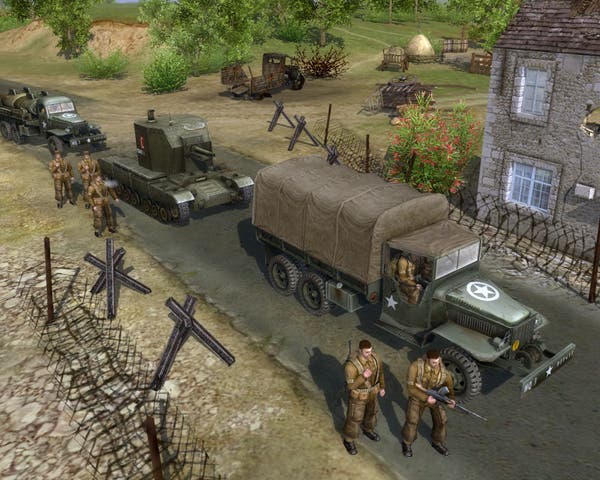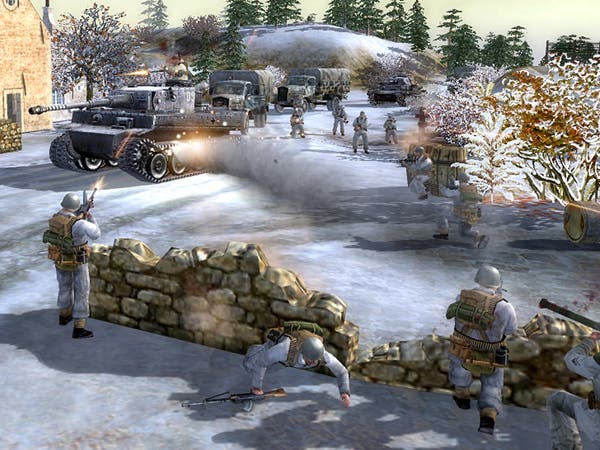Faces of War
A look at Best Way's Heroes of WWII follow-up.
This March will see the release of Faces of War, currently in development at Ukrainian studio Best Way. It's a follow-up to 2004's Soldiers: Heroes of World War II, but no, they didn't just change the series' name because Heroes of World War II 2 would sound stupid.
The name change is due to the fact that Best Way has switched publishers, which means Faces of War will be brought to town by Ubisoft. And as you might expect, that isn't the only change to the game, as Best Way's Anatoly Subbotin is keen to point out.
For starters, it's set towards the end of the war, between the summer of 1944 and the spring of 1945. You can play as the Allies, Soviets and Germans, and missions are based on real historical events, such as D-Day and the Battle of the Bulge.
But before we let Subbotin wax lyrical about all of the game's new features, let's start with a trickier question: does the world really need another World War II game? What's so special about this one?
"It's got very different gameplay. It's a very interesting cross-genre game," Subbotin begins.
"Is it a first-person shooter? At some points, yes - if you put the camera really close up to a soldier while you're in direct control, it's very close to a first- or third-person action game.
"Is it a tactical game? Definitely. Is it an RTS game? At some points, because in some missions you have hundreds of soldiers to control using point-and-click. There are many things taken from different genres and different games, so it's a very unique experience."
Freedom of choice

It all ties in with the game's "freeplay" system, which is designed to give you a huge array of options when it comes to working out how to complete each level. Subbotin explains that when a designer is planning out a mission, he'll have five or six broad ideas of how that mission can be completed - "But then the player might easily find another way to complete it."
"There is a starting point and an end point for each mission, so you have a global objective. How you reach this global objective is absolutely up to you - you can attack from the left, the right, the front; you can just storm in, or you can send in a sniper to kill the crew operating a heavy gun, and then use the gun against the enemy; or find a different way..."
As in the previous game, you can give general orders and also take direct control of individual soldiers and vehicles, mowing down and blowing up whoever and whatever takes your fancy. In short, there are plenty of options - you can perform single or squad-based melée attacks if your men run out of bullets, for example, and switch between manual and automatic combat.
However, it all takes place on a much grander scale now. "We wanted to make the game massive," Subbotin says, "So you're not just controlling a couple of soldiers, but you've got hundreds of soldiers running around together, and you feel like a commander in charge of a much grander operation."
"There are still some old fashioned Soldiers-type missions where you have a few guys doing, say, a hit and run mission, but much more of the game is around the bigger operation."
Super smart shooters

In order to make this work, they had to develop a brand new AI system to ensure that every single soldier on the battlefield is smart enough to hold their own. "These soldiers act and react like real soldiers - not like clowns or clones," Subbotin says.
He explains that the soldiers fight independently and behave differently from one another, and they're able to think a problem through if the tactics they're employing aren't working. So if a sub-machine gunner finds he can't hit that bloke on the second floor of that building after a few attempts, for example, he will pull out a grenade instead.
Or, if a soldier sees a tank approaching while he's busy wasting a load of troops with his machine gun, he'll switch to his bazooka and attack the tank - from the side, of course, because he knows he won't be able to do much damage to the front. Soldiers will also watch each others' backs and step up when needed, so if one of your snipers is killed, his mate will take over his position.
In fact, the AI is so good that you needn't do much work at all if you don't want to. If you've set the game's difficulty level to easy, Subbotin explains, "Some of the missions could be played like a big movie. So you just do a few clicks - okay, attack here, attack there - and then you can sit back, relax, and see how your tactics unfold on the battlefield."
Tough talking

The difficulty level has been a key issue for the team during the game's development, thanks to some of the feedback they received last time around.
"There were quite a few complaints that Soldiers was too tough. It was definitely maybe a bit too hardcore, and this made it not very enjoyable for some gamers who couldn't get through the first couple of missions," Subbotin concedes.
So this time, they ensured that there would be a range of difficulty levels so that the game would attract "gamers who are maybe going to be attracted by the great visuals, or maybe don't even play PC games but play console games, or play different genres but want to play something new."
But have no fear, hardcore gamers - things are still seriously tough at the other end of the scale. "You have to do a lot of planning, tactical advances and so on - you're not going to win the game Rambo-style, as you can when playing on the easy level."
"This is part of the idea of branching missions in a campaign according to difficulty level. So as you progress through the game, you get more skillful. As you get deeper into the campaign, maybe you master direct control better - then you can change the experience by adding more and more difficulty."
Sweet sixteen

There have also been some changes to the multiplayer mode, too, Subbotin says. It's designed for up to 16 players, and features new front end and in-game interfaces. As in Heroes of World War II, you'll be able to rifle through your dead enemies' pockets and help yourself to any items they won't be needing any more. Which is all of them, obviously.
The multiplayer game will run on a dedicated Gamespy server and you can expect several new modes, "Plus a tremendous increase in the graphics quality," according to Subbotin.
Of course, they all say that, but from what we've seen of Faces of War there really is a quite astonishing level of environmental detail and some highly impressive visual effects. The camera has more freedom of movement than the one in the previous game, and an even more complicated physics system means they've taken the "destroy everything" element even further. Plus you can expect more dynamic lighting, enhanced particle effects, and an overall higher level of detail, just for a change.
The game also now has snow and ice physics, which means you're faced with even more challenges. For example, let's say you're hooning along in a tank when you find a frozen river in your way. You'll need to think twice about rolling on through, since if the tank's too heavy it'll break the ice and sink, leaving your soldiers to try and clamber out before they become human lollies.
Characters move much more realistically than in the previous game - each soldier has around 40 individual animations, apparently. They've got more movement options, too - including three different running speeds, no less. Plus, a new awards system means you can see how your soldiers performed in battle, and (providing they made it out alive, of course) take them with you from one combat situation to another.
All in all, it seems that Faces of War is shaping up rather well. So if it ends up playing as good as it looks, what will the future hold for the series - is there any chance of a sequel?
Well, that depends on how many people buy this one, Subbotin says - and also what the development team is interested in doing next.
"Maybe we'll do Faces of War 2 or whatever, or maybe we'll feel that World War II is not fun any more and we'll do a sci-fi game or something... With this technology, you just change the setting and you can do amazing stuff."
What kind of amazing stuff? "I don't know, Indian wars, Gulf war, aliens - whatever."
Alternatively, the team could decide to turn their attention away from the PC all together for a while, as Subbotin explains.
"I don't see why a similar game to Faces of War couldn't be played on consoles. The gameplay would definitely have to be changed, so it would probably be more like a single soldier action game or a small squad action game."
As for which consoles it might appear on: "Maybe on Xbox 360, because the PS2 is probably not powerful enough to support such a complicated physics system." PlayStation 3? "Maybe."
"But that's a distant possibility - now we have to concentrate on getting this right before we think about what we're going to do next."
Fair enough - roll on March, when we'll find out if they succeeded.

